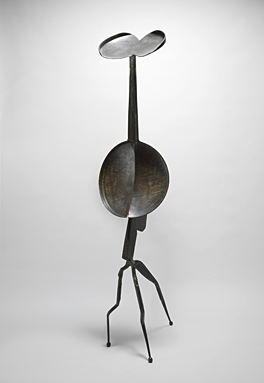
|
ABOVE: David Smith, Tanktotem III, 1953. Steel, 84 1/2 x 27 x 20 inches. Collection of Mr. and Mrs. David Mirvish, Toronto. Photo by David Heald © 2006 The Estate of David Smith/Licensed by VAGA, New York.
|
|
|






By the end of 1951, Smith began conceiving his sculptures as parts of titled series that allowed him to resolve different formal issues over a number of pieces. These series were produced haphazardly: numbered works were made out of order and seldom completed, and Smith simultaneously maintained several series at any given time. The first of these series, the Agricolas, continued to emphasize the articulation of line in space, but turned away from the representational aspects of Smith’s more symbolic works in favor of increasing abstraction.
Smith began his second series, the Tanktotems, in 1952. In these works he established a bold new aesthetic statement, dispensing with pedestals and creating sculptures that could stand directly on the floor. Smith referred to these works as “personages,” a term that would encompass much of his work during the 1950s, including his Sentinels and a number of individual sculptures not made within the bounds of a series. With their new emphasis on verticality, Smith’s personages evoke associations with the human figure, and many seem to cast a watchful gaze upon their surroundings. Appropriately enough, during these same years Smith began to arrange his sculptures in the fields outside his home in Bolton Landing, New York. There, in an ever-expanding installation, they took on even more distinct personalities, becoming steel creatures that lumbered through the wilderness, imbued with a life of their own.
The late 1950s also saw explosive developments in Smith’s use of color. From the beginning he had created sculpture in dialogue with painting, frequently replicating two-dimensional effects in the structures of his works and almost always painting their surfaces. Now Smith began to employ more vibrant colors in greater variety, with single pieces featuring stunning blues, yellows, reds, and greens. Furthermore, he began to apply these paints with visible brushstrokes, adding a new gestural expressionism to his work while also emphasizing the planar and solid geometric forms he increasingly created during this period. The brightly colored planar surface would become a hallmark of much of Smith’s late work, and was closely related to his simultaneous adoption of burnished stainless steel, seen most famously in his Cubi series.
|